
Diagnosing canine nasal cancer can be a challenging process, but it's crucial to identify the disease early on. Nasal cancer in dogs often presents with symptoms such as nasal discharge, facial swelling, and loss of appetite.
A definitive diagnosis typically requires a biopsy, which involves taking a tissue sample from the nasal cavity. The biopsy is then examined under a microscope to determine the type and extent of the cancer.
The treatment options for canine nasal cancer depend on the stage and type of the disease. Surgery is often the primary treatment, followed by radiation therapy to eliminate any remaining cancer cells.
The prognosis for dogs with nasal cancer varies depending on the extent of the disease and the effectiveness of the treatment.
If this caught your attention, see: Canine Lupus Disease
Symptoms and Diagnosis
Canine nasal cancer can be a challenging diagnosis to make, but there are some common signs to look out for. Nasal discharge, often containing mucous, pus, and blood, is the most common clinical sign of nasal cancer in dogs.
A runny nose can be a subtle sign, but it's essential to check your dog's bedding and blankets for nasal discharge as well. Excessive sneezing is another common symptom, but it can also be caused by allergies or upper respiratory infections.
Here are some common clinical signs of nasal cancer in dogs:
- Nasal discharge
- Excessive sneezing
- Loud snoring
- Bloody nose
- Rubbing or pawing at face
- Facial deformity
- Seizures
If you notice any of these symptoms, it's crucial to have your dog examined by a veterinarian as soon as possible. A diagnosis of nasal cancer can be complicated, and other diseases of the nasal cavity may have similar symptoms. Your veterinarian will use a variety of tests, including a tissue biopsy, to determine if your dog's symptoms are caused by cancer and what type of cancer is present.
Recommended read: Lifespan of Dog with Cushing's
Symptoms
If your dog is displaying any of the following symptoms, it's essential to have them examined by a veterinarian as soon as possible.
A runny nose or nasal discharge is the most common clinical sign of nasal cancer in dogs. The discharge may contain mucous, pus, and blood, and it's crucial to check your pet's bedding and blankets for any signs of nasal discharge.
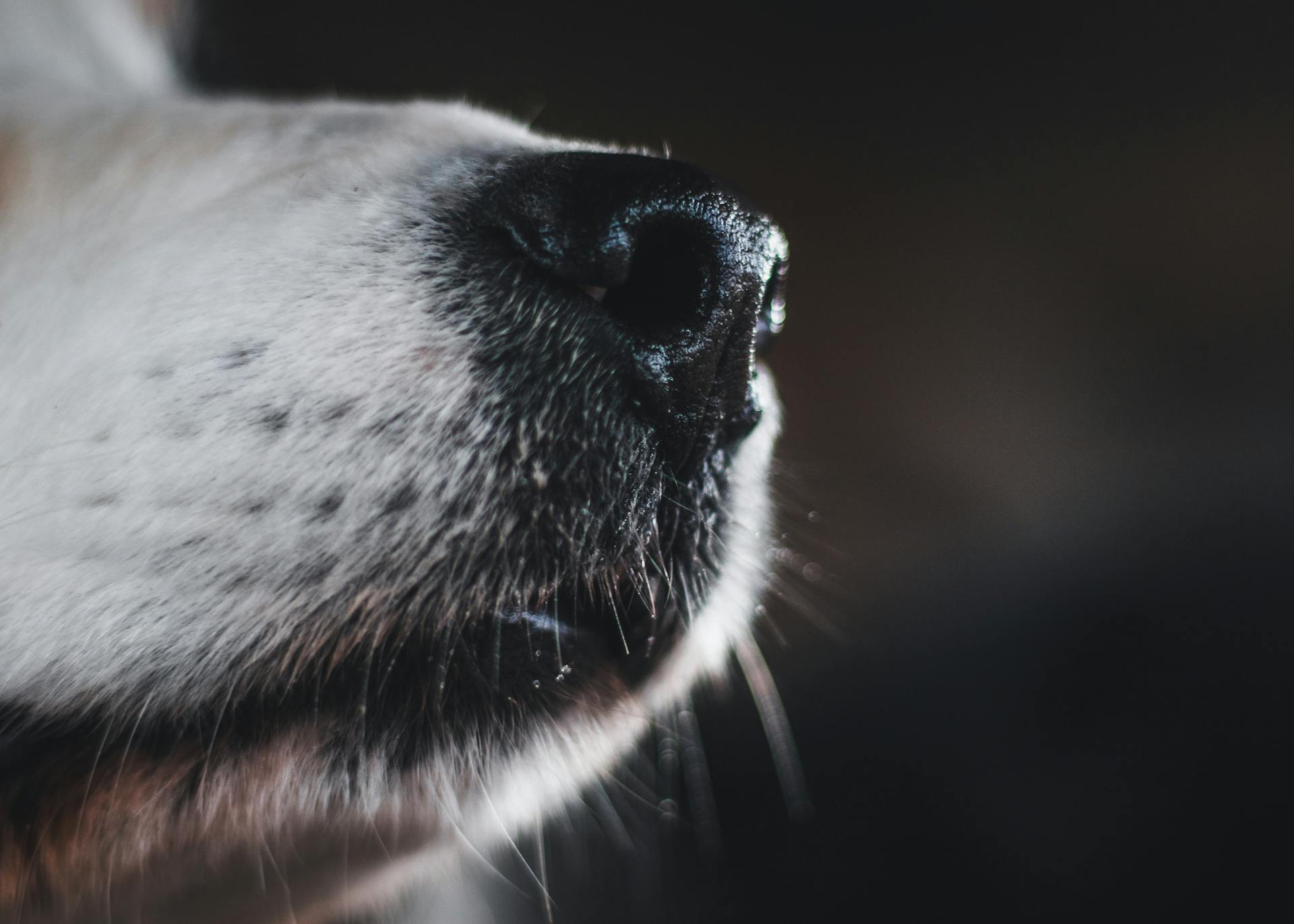
Excessive sneezing is another common sign, and while it can be caused by allergies or infections, it's essential to notify your veterinarian if the sneezing persists even after medication.
Loud snoring or noisy breathing can be a sign of a tumor blocking the nasal airways, and if your dog has always been a quiet sleeper, this could be a red flag.
A bloody nose can be caused by various factors, including trauma, allergies, or a tumor, and if you notice persistent bleeding, it's crucial to take your dog to the veterinarian for examination.
Here are some common symptoms of nasal cancer in dogs:
- Nasal discharge
- Excessive sneezing
- Bloody nose
- Loud snoring or noisy breathing
- Facial deformity
- Rubbing or pawing at the face
- Seizures
- Weight loss or gain
- Persistent cough
- Wounds that won't heal
Keep in mind that some symptoms, such as sneezing and nasal discharge, can be caused by other conditions, so it's essential to have your dog examined by a veterinarian to determine the underlying cause.
Diagnosing
Diagnosing nasal tumors in dogs can be a complex process. Your veterinarian will likely start by performing a physical examination to check for facial symmetry and obstruction of air flow in each nasal opening.
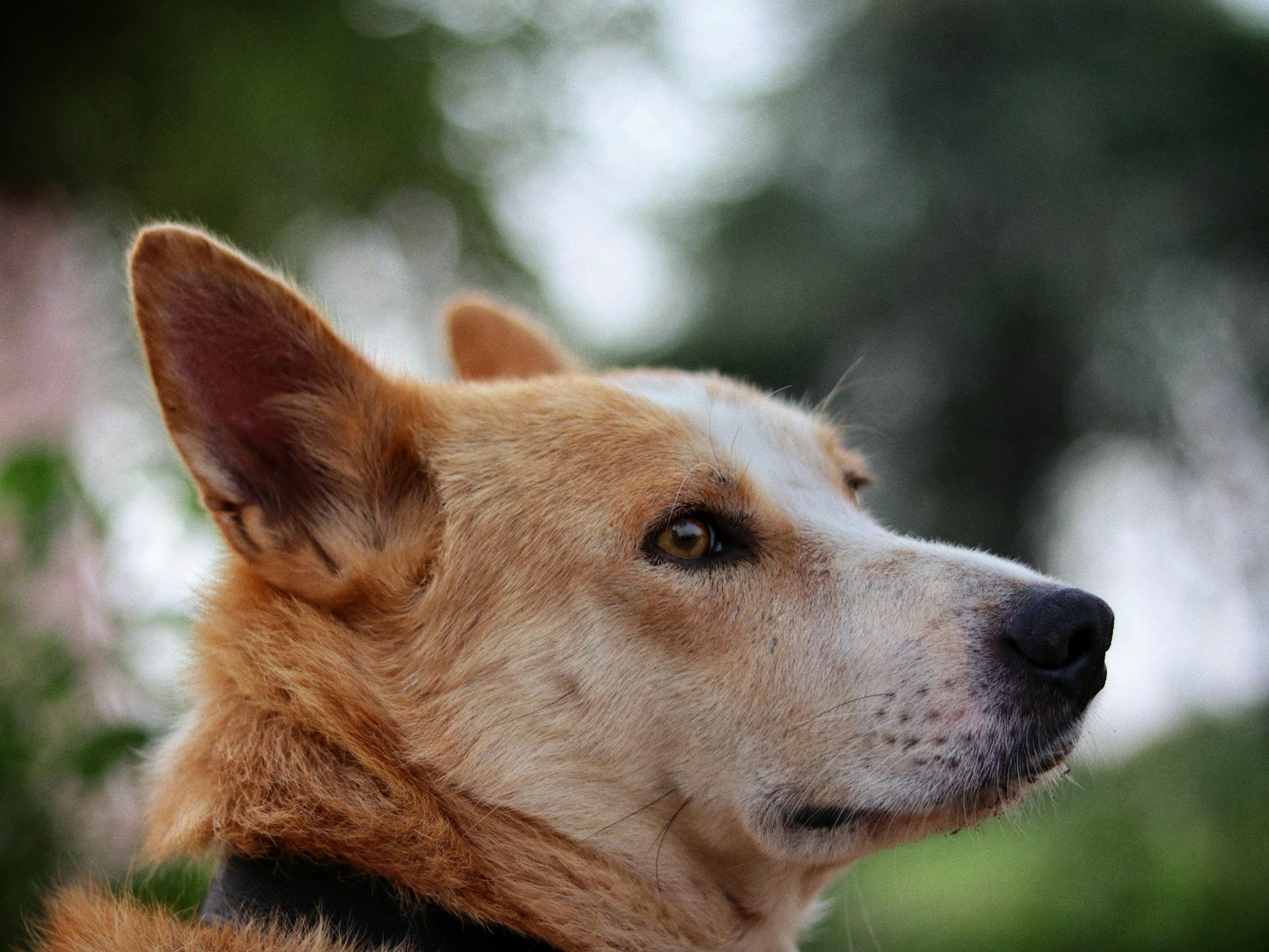
Blood work and tissue biopsy are also important tools in the diagnostic process. A tissue biopsy involves taking a sample of tissue from the nasal tumor for further examination under a microscope.
The veterinarian may also use imaging techniques such as X-rays, CT scans, and MRIs to determine the presence and extent of the tumor. A CT scan is often preferred over X-rays to get a more detailed look at the tumor.
A biopsy needle may be inserted into the tumor to retrieve tissue cell samples for examination. The veterinarian may also take a mucus sample from your dog's nasal discharge to check for abnormal cells.
Here are some common diagnostic tests used to diagnose nasal tumors in dogs:
- Tissue biopsy
- CT scan
- MRIs
- X-rays
- Conventional radiography (x-rays)
- Three-view thoracic radiographs of the lungs
- Needle aspirates of the local lymph nodes
- Nasal hydropulsion using a high-pressure saline infusion
- Abdominal ultrasound
The veterinarian may also recommend additional tests such as lung radiographs and examination of lymph nodes to check if the cancer has metastasized.
Staging and Prognosis
Staging and prognosis are crucial for determining the severity of canine nasal cancer and selecting the best treatment options. Staging tests allow veterinarians to determine how severe the cancer is and if it has spread.
The Adams modified staging system is the most recent system used for canine nasal tumors. It categorizes the cancer into four stages based on radiographic or CT findings.
Here's a breakdown of the four stages:
The prognosis varies depending on the stage and type of cancer. Dogs with unilateral intranasal involvement confined to the nasal cavity have the longest median survival time of 23.4 months when treated with definitive radiotherapy.
Treatment Options
Radiation therapy is the preferred standard of treatment for canine nasal tumors. It's often used because surgery in the nasal region can be difficult.
Radiation therapy can be delivered in different ways, including conventionally fractionated radiation therapy (CFRT) and stereotactic radiation (SRS/SRT). SRS/SRT is a newer and more advanced form of radiation therapy that delivers high doses of radiation with sub-millimeter precision.
This means that SRS/SRT can cause maximum damage to the tumor while minimizing damage to surrounding healthy tissues. It also requires fewer treatment sessions, typically 1-3 sessions, which can be fewer anesthetic events and less disruption to your schedule.
You might enjoy: Canine Leishmaniasis Treatment
SRS/SRT can also lead to fast recovery with little to no side effects. It's even able to treat tumors that were previously considered untreatable.
Chemotherapy is sometimes used in conjunction with radiation therapy or surgery, but it's not always effective for canine nasal tumors. Different chemotherapeutic agents have been used, often with disappointing results.
However, some combinations of chemotherapy and surgery or radiation have shown promise. For example, treatment with alternating carboplatin and doxorubicin in conjunction with oral piroxicam may benefit dogs with nasal adenocarcinoma, carcinoma, and sarcoma.
Here are some common treatment options for canine nasal tumors:
- Radiation therapy: the preferred standard of treatment
- SRS/SRT: a newer and more advanced form of radiation therapy
- Chemotherapy: sometimes used in conjunction with radiation therapy or surgery
- Combination of chemotherapy and surgery or radiation: may be beneficial for some dogs
Note: It's essential to consult with a veterinary oncologist to determine the best treatment plan for your dog.
Stereotactic Radiation (SRS/SRT)
Stereotactic Radiation (SRS/SRT) is a game-changer for canine nasal cancer treatment. It allows for high doses of radiation to be delivered with sub-millimeter precision, minimizing damage to healthy tissues nearby.
This means maximum damage to the tumor and minimal collateral damage to surrounding tissues. In contrast to traditional radiation therapy, SRS/SRT requires only 1-3 treatment sessions, which is a significant reduction compared to 15 to 30 sessions.
Explore further: Canine Cancer Treatment
Fewer treatment sessions mean fewer anesthetic events, more safety, and less disruption to your schedule. Fast recovery with little to no side effects is also a major advantage of SRS/SRT.
Tumors previously considered untreatable can now be treated with SRS/SRT. This is a significant breakthrough in canine nasal cancer treatment, offering new hope for pet owners and their furry friends.
Here's a comparison of SRS/SRT and traditional radiation therapy:
SRS/SRT is a more advanced and effective form of radiation therapy, making it a preferred option for canine nasal cancer treatment.
Life Expectancy and Prognosis
Life expectancy and prognosis for canine nasal cancer vary depending on the type of cancer, its stage, and how early it's treated. The median survival time for dogs after advanced radiation therapy ranges from 6-18 months.
The earlier the cancer is diagnosed and treated, the better the chances of successful treatment. This is a crucial factor in determining the prognosis.
Expand your knowledge: Canine Cancer Prognosis
Staging, a process of tests to determine the severity of the cancer, may impact the prognosis and treatment options. It's essential to work with a veterinarian or oncologist to determine the best course of action.
According to the Adams 2009 modified staging system, dogs with unilateral intranasal involvement confined to the nasal cavity have the longest median survival time of 23.4 months when treated with definitive radiotherapy. Those with cribriform involvement have the shortest median survival time of 6.7 months.
Factors contributing to the prognosis include the tumor type, stage, location, and the dog's overall health. Early intervention is critical for improving outcomes and achieving a higher life expectancy for dogs diagnosed with nasal cancer.
Malignant tumors may pose greater challenges, emphasizing the importance of timely veterinary care. Dogs diagnosed and treated in the early stages often experience improved outcomes.
A delicate balance is required between aggressive treatments and maintaining a good quality of life. Veterinary teams prioritize not only eradicating tumors but also the overall well-being of the dog.
Check this out: Canine Mouth Cancer Life Expectancy
Types and Subtypes
Canine nasal cancer is a complex and multifaceted disease, and understanding the different types and subtypes is crucial for effective treatment and management.
There are two main categories of nasal tumors in dogs: carcinomas and sarcomas. Carcinomas account for nearly two-thirds of nasal tumors, including adenocarcinoma, squamous cell carcinoma, and undifferentiated carcinoma.
Some of the most common nasal tumor types in dogs include adenocarcinoma, squamous cell carcinoma, and undifferentiated carcinoma. Adenocarcinoma often infiltrates surrounding tissues, making early diagnosis essential. Squamous cell carcinoma typically develops on the nasal planum and can be locally aggressive. Undifferentiated carcinoma is a less common but aggressive type of cancer.
Here are some specific types of nasal tumors in dogs:
- Adenocarcinoma: originates in the glands and is known for its invasive nature.
- Squamous cell carcinoma: typically develops on the nasal planum and can be locally aggressive.
- Undifferentiated carcinoma: a less common but aggressive type of cancer.
- Fibrosarcoma: originates from the connective tissue surrounding the bones within the nasal area.
- Chondrosarcoma: found on the nose cartilage and mostly affects young dogs.
Types and Subtypes
Adenocarcinoma is the most common nasal tumor in dogs. It's a type of cancer that can be treated with radiation therapy, and it has a relatively better long-term prognosis compared to other types of nasal tumors.
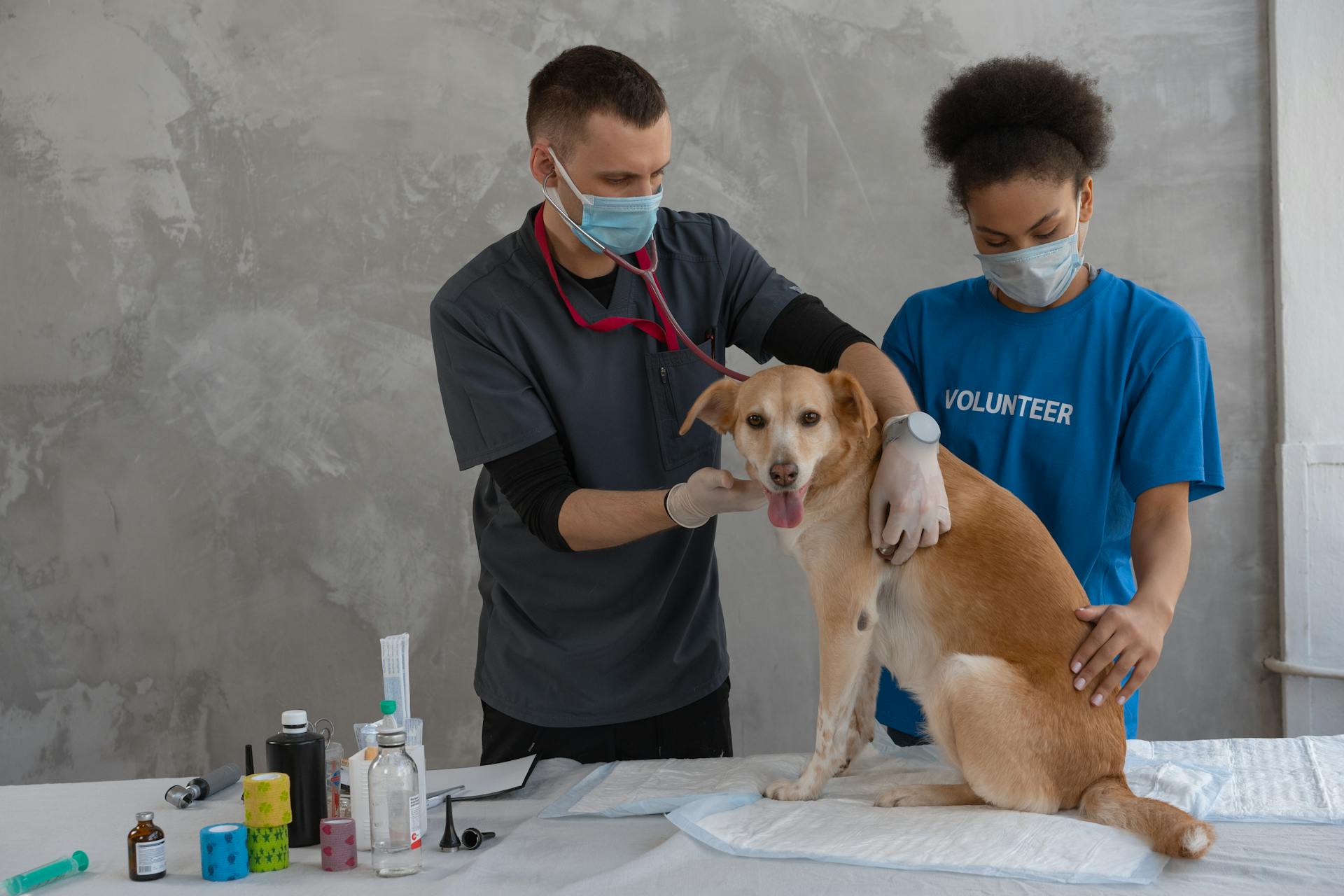
Long-nosed dogs living in urban environments are at higher risk for developing nasal tumors, including adenocarcinoma. This is because they are more likely to be exposed to environmental carcinogens and pollutants.
The p53 gene is essential for preventing cancer, but mutations in this gene can increase the risk of developing nasal tumors. In fact, a study found that 11 out of 19 nasal adenocarcinomas had p53 protein accumulation in the nucleus, suggesting that p53 gene and protein mutation may participate in nasal tumorigenesis.
COX-2 expression is also associated with nasal tumorigenesis, as it can promote angiogenesis and tumor invasion. In three studies, 71% to 87% of nasal carcinomas were found to be COX-2 positive.
Here are some key statistics about nasal cancer in dogs:
Male dogs are at higher risk of developing nasal cancer than female dogs, and long-nosed dogs living in urban environments are also at higher risk.
Types of
There are several types of nose cancer in dogs, including carcinomas and sarcomas. Carcinomas are the most common type, accounting for nearly two-thirds of nasal tumors in dogs.
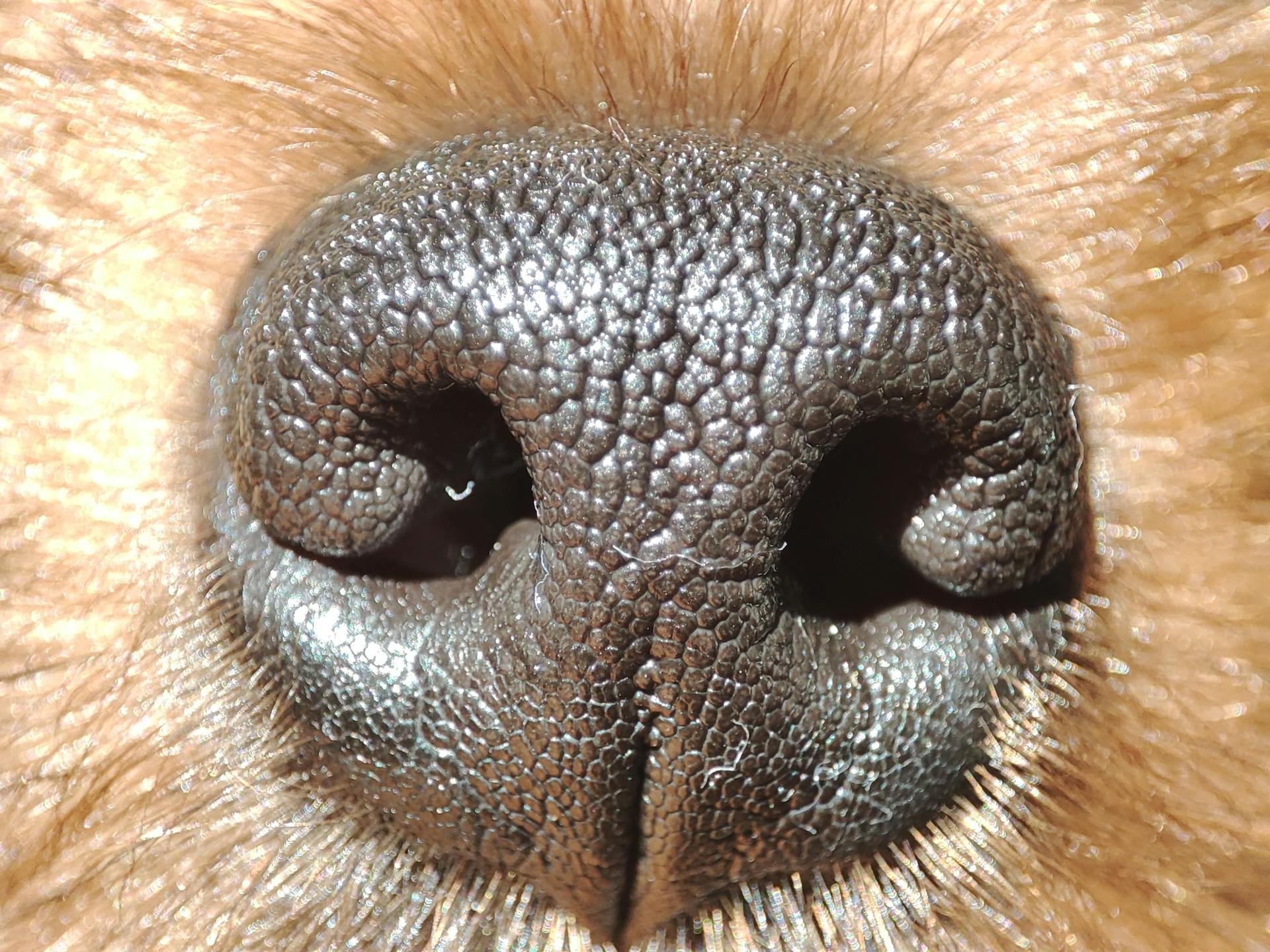
Adenocarcinoma is a type of carcinoma that originates in the glands and is known for its invasive nature. Nasal adenocarcinoma often infiltrates surrounding tissues, making early diagnosis crucial.
Squamous cell carcinoma is another type of carcinoma that typically develops on the nasal planum, the hairless external surface of the nose. While it may not spread as rapidly as other types, it tends to be locally aggressive, affecting surrounding normal tissue.
Fibrosarcoma is a type of sarcoma that originates from the connective tissue surrounding the bones within the nasal area.
Here's a breakdown of the most common nasal tumor types in dogs:
- Adenocarcinoma
- Squamous cell carcinoma
- Fibrosarcoma
- Undifferentiated carcinoma
- Undifferentiated sarcoma
These cancers can be aggressive and require prompt attention. If left untreated, the survival time is typically 3-5 months after diagnosis.
Round Cell
Round Cell cancers are a group of aggressive tumors that affect dogs. They can occur in various parts of the body.
Lymphoma is a type of Round Cell cancer that affects a dog's immune system. It's the most common type of cancer in dogs.
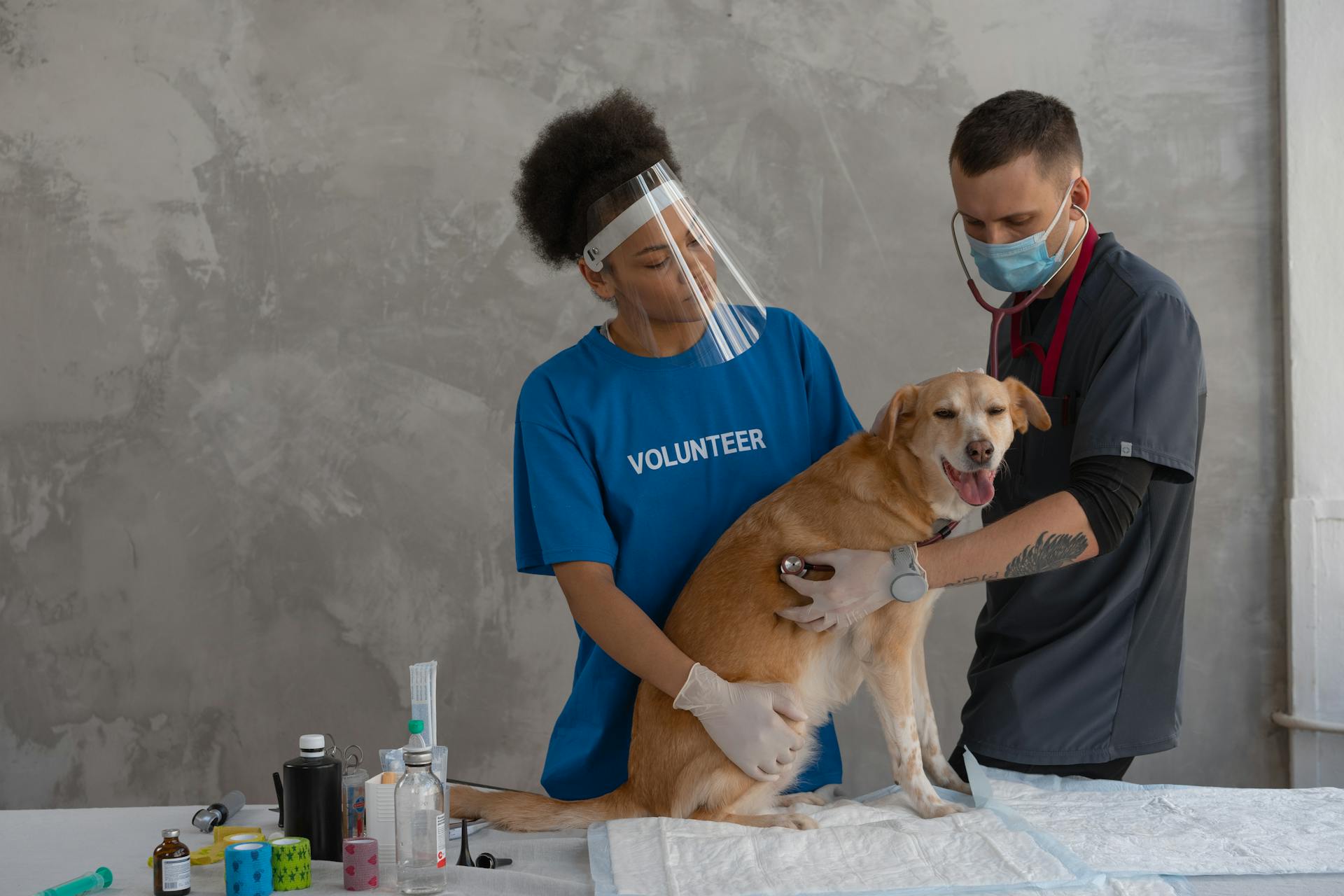
Mast Cell Tumors are another type of Round Cell cancer that can appear as lumps or swellings on a dog's skin. They can be benign or malignant.
Multiple Myeloma is a rare and serious type of Round Cell cancer that affects a dog's bone marrow. It can cause a range of symptoms, including anemia and bone pain.
Here are the types of Round Cell cancers mentioned in this article:
- Lymphoma
- Mast Cell Tumors
- Multiple Myeloma
- Plasmacytoma
- Thymoma Cancer
Statistics and Facts
Canine nasal cancer is a serious condition, and understanding the statistics and facts surrounding it can help you make informed decisions about your furry friend's care.
Nasal tumors account for approximately 1% to 2% of all cancers in dogs, making it a relatively rare but still significant issue.
Most nasal tumors are malignant, with carcinomas being the most common type, accounting for 70% of intranasal tumors.
Adenocarcinoma and squamous cell carcinoma are the most commonly reported types of carcinomas in dogs.
If left untreated, the survival time for dogs with nasal cancer is typically 3-5 months after diagnosis.
Metastasis, or the spread of cancer to other parts of the body, is relatively rare at the time of diagnosis, occurring in about 4% of animals.
Managing the Disease
Integrative therapies can play a role in your dog's cancer treatment plan, such as acupuncture to help manage symptoms like nausea.
Acupuncture may help manage symptoms, but it's essential to note that one study showed that traditional Chinese veterinary medicine modalities can improve clinical signs and decrease mass size in dogs with nasal adenocarcinoma.
Regular veterinary check-ups are crucial for early detection of nasal tumors and recurrence, allowing for proactive management of the disease.
These check-ups also provide opportunities for open communication between pet owners and veterinary professionals, enabling early detection and addressing potential challenges promptly.
Nasal hydropulsion can be used as a palliative treatment in case of obstructive nasal tumors, but it's generally used when radiation therapy or surgery is not affordable, available, or desired.
Recommended read: Canine Cancer Detection
Integrative Therapies
Integrative Therapies can play a significant role in your dog's cancer treatment plan.
Acupuncture may help manage symptoms of cancer treatment, such as nausea, in your dog.
Yunnan baiyao is a supplement that may help stop bleeding in dogs with nasal tumors, which can be especially helpful if their tumor bleeds a lot.
One study showed that using traditional Chinese veterinary medicine modalities improved clinical signs and decreased the mass size in a Pug diagnosed with nasal adenocarcinoma.
Nasal hydropulsion is a palliative treatment that sends a jet of saline up the nasal passages to "blow out" pieces of the tumor, often used when radiation therapy or surgery is not an option.
Pain
Pain is a significant concern for dogs with nasal cancer, as it can cause discomfort and pressure in the head.
Most dog cancers don't cause pain, but nasal cancer is an exception.
Any extra pressure or obstruction in the head can cause pain, similar to how you might feel when you have something going on in your head.
Nasal cancer can be painful due to the lack of extra room in the head, making even minor issues feel uncomfortable.
Pain relief and relieving obstructions are crucial parts of addressing nasal cancer, alongside treatment.
Palliative care can also help alleviate symptoms, manage pain, and provide comfort for dogs with advanced nasal tumors.
Managing pain is essential for enhancing the quality of life for dogs with nasal cancer.
Related reading: Canine Cancer Pain Management
Side Effects

Radiation therapy for nasal tumors in dogs may cause mild to moderate skin irritation in the area being treated, manifesting as redness, itching, or hair loss.
The severity of side effects can vary from dog to dog, and veterinarians work closely with pet owners to manage and mitigate these effects.
Some dogs may experience long-term changes in the skin and underlying tissues after radiation therapy, but these changes are generally manageable and closely monitored by the veterinary team.
Regular communication with the veterinary team is essential to address any concerns and make adjustments to the treatment plan if necessary.
Here are some general side effects of radiation therapy to be aware of:
- Radiation therapy may cause mild to moderate skin irritation in the area being treated.
- Long-term changes in the skin and underlying tissues are possible, but generally manageable.
Risk Mitigation
Risk Mitigation is key to managing the disease in dogs. Regular veterinary check-ups are essential for identifying potential causes of cancer in its infancy.
These check-ups serve as routine wellness rehearsals for our pets, ensuring they receive timely care and attention. By catching potential issues early on, we can take proactive measures to maintain their vitality.
Environmental considerations play a crucial role in minimizing exposure to potential hazards. This includes making informed choices in nutrition and avoiding pollutants like tobacco smoke.
Creating a canine-friendly environment provides a haven where their health thrives, minimizing the risk of cancer in dogs. This mindful approach also contributes to their overall happiness and vitality.
Genetic screening is a powerful tool in identifying predispositions to nasal tumors. This is especially important for breeds with known predispositions for cancer in dogs.
Here are some breeds that are prone to nasal tumors:
By being aware of these breeds and taking proactive measures, we can navigate their health journey with foresight and tailored interventions.
Frequently Asked Questions
What is end stage nasal cancer in dogs?
End-stage nasal cancer in dogs is characterized by advanced symptoms such as seizures, facial deformity, and frequent nosebleeds, indicating a critical need for veterinary attention. Early detection is crucial to manage the condition and improve the dog's quality of life.
What does nose cancer look like on a dog?
Nose cancer in dogs can cause facial swelling, a misshapen nose, and bulging eyes due to the tumor's growth. If left untreated, the cancer can also spread to the skull, leading to severe consequences
What can be mistaken for nasal cancer?
Nasal cancer symptoms can be mistaken for common conditions like sinus infections or sinusitis, making early detection challenging. If you're experiencing persistent nasal or sinus issues, it's essential to consult a doctor for proper evaluation and diagnosis.
Featured Images: pexels.com


